Hearing Loss
Types of Hearing Loss
There are three basic types of hearing loss: conductive hearing loss, sensorineural hearing loss and mixed hearing loss.
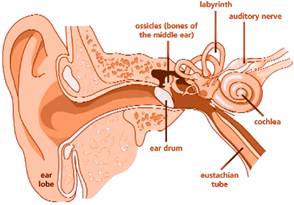
A. Conductive Hearing Loss
I. Attributes
- Occurs when sound is not conducted efficiently the outer ear canal to the eardrum and the tiny bones, or ossicles, of the middle ear.
- Signaled by a reduction in sound level, or ability to hear faint sounds
- Often can be corrected with surgery
http://www.ich.ucl.ac.uk/factsheets/families/F010074/images/ear.gif
II. Possible causes
- Fluid in the middle ear from colds, allergies (serous otitis media), poor Eustachian tube function, ear infection (otitis media), perforated eardrum, benign tumors
- Impacted earwax (cerumen)
-Infection in the ear canal (external otitis)
-Presence of a foreign body
-Absence or malformation of the outer ear, ear canal, or middle ear
B. Sensorineural Hearing Loss
I. Attributes
- Occurs when there is damage to the inner ear (cochlea) or to nerve pathways from the inner ear (retrocochlear) to the brain.
- Cannot be corrected, and is a permanent loss.
- Involves a reduction in sound level, or ability to hear faint sounds, but also affects speech understanding, or ability to hear clearly.
II. Possible Causes
- Disease and tumors
- Birth injury
- Drugs that are toxic to the auditory system
- Genetic syndromes
- Result of noise exposure
- Viruses
- Head trauma
- Aging
C. Mixed Hearing Loss
I. Attributes
- Sometimes occurs in combination with a sensorineural hearing loss.
- There may be damage in the outer or middle ear and in the inner ear (cochlea) or auditory nerve; this is referred to as “mixed hearing loss.” – Asha.org
Degrees of Hearing Loss
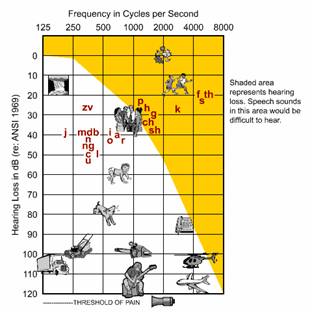
- Degrees = severity of the loss
- There are five broad categories generally used
Normal range or no impairment = 0 dB to 20 dB
Mild loss = 20 dB to 40 dB
Moderate loss = 40 dB to 60 dB
Severe loss = 60 dB to 80 dB
Profound loss = 80 dB or more
http://chppm-www.apgea.army.mil/hcp/images/chart01.gif
Treatments
“Approximately 5% to 10% of adult hearing problems are medically or surgically treatable. The percentage is higher in children if middle ear disease, such as ear infection, is the cause.”
A. Hearing Aids
The majority of hearing aids sold today are canal hearing aids and in-the-ear hearing aids.
 - Vary in size, design, ,but have the same components - Vary in size, design, ,but have the same components
http://babyhearing.org/images/HearingAmp/Choices/hearing_aid.jpg
I. Types
- In-the-canal and completely-in-the-canal aids
- Contained in a tiny case that fits partly or completely into the ear canal.
- Smallest aids available, and offer some cosmetic and listening advantages
- In-the-ear aids:
- All parts of aid contained in a shell that fills in the outer part of the ear.
- Larger than canal aids, may be easier to handle
- Behind-the-ear aids:
- All parts contained in a small plastic case that rests behind the ear
- Case is connected to an earmold by a piece of clear tubing.
- Often chosen for young children for safety and growth reasons.
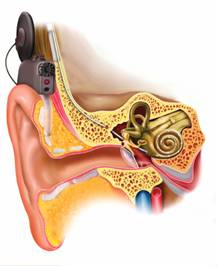 B. Cochlear Implants B. Cochlear Implants
A cochlear implant is a device that provides direct electrical stimulation to the auditory nerve.
In sensorineural hearing loss where there is damage to the tiny hair cells in the cochlea, sound cannot reach the auditory nerve.
It does not result in “cured hearing”
With a cochlear implant, the damaged hair cells are bypassed and the auditory nerve is stimulated directly.
Thorough evaluation is conducted before a patient receives the implant, to decide whether they’re a candidate.
http://www.isvr.soton.ac.uk/soecic/XSC-EARC.jpg
I. Internal Parts
- Receiver and electrodes
- The receiver is just under the skin behind the ear.
- The receiver takes the coded electrical signals from the transmitter and delivers them to the array of electrodes that have been surgically inserted in the cochlea.
- The electrodes stimulate the fibers of the auditory nerve and sound sensations are perceived.
II. External Parts
- Microphone
- Speech processor
- Transmitter
The microphone looks like a behind-the-ear hearing aid. It picks up sounds - just like a hearing aid microphone does -- and sends them to the speech processor .
The speech processor may be housed, with the microphone, behind the ear or it may be a small "box" worn in a chest pocket.
The speech processor is a computer that analyzes and digitizes the sound signals and sends them to a transmitter worn on the head just behind the ear.
The transmitter sends the coded signals to an implanted receiver just under the skin.
http://asha.org
Prevention of Hearing Loss
Protect your ears in the workplace. Specially designed earmuffs that resemble earphones can protect your ears by bringing most loud sounds down to an acceptable level. Foam, pre-formed, or custom-molded earplugs made of plastic or rubber also can effectively protect your ears from damaging noise.
Have your hearing tested. Consider regular hearing tests if you work in a noisy environment. Regular testing of your ears can provide early detection of hearing loss. Knowing you've lost some hearing means you're in a position to take steps to prevent further hearing loss.
Avoid recreational risks. Activities such as riding a snowmobile, hunting, and listening to extremely loud music for long periods of time can damage your ears. Wearing hearing protectors or taking breaks from the noise during loud recreational activities can protect your ears. Turning down the volume when listening to music can help you avoid damage to your hearing.
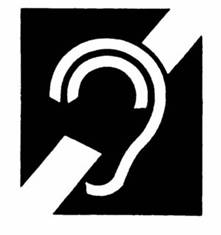
Coping with Hearing Loss
* Position yourself to hear. Face the person with whom you're having a conversation.
* Turn off background noise. For example, noise from a television may interfere with conversation.
* Ask others to speak clearly. Most people will be helpful if they know you're having trouble hearing them.
http://www.mediateletipos.net/wp-content/images/2006/03/hearing_loss.JPG
* Choose quiet settings. In public, such as in a restaurant or at a social gathering, choose a place to talk that's away from noisy areas.
* Consider using an assistive listening device. Hearing devices, such as TV-listening systems or telephone-amplifying devices, can help you hear better while decreasing other noises around you.
http://mayoclinic.com
Living with Hearing Loss
· Alerting devices. These devices alert you to a particular sound (such as the doorbell, a ringing telephone, or a baby monitor) by using louder sounds, lights, or vibrations to get your attention.
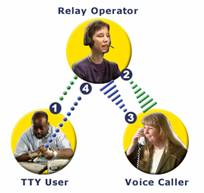 · Television closed-captioning. Television closed-captioning makes it easier to watch television by showing the words at the bottom of the screen so that you can read them. Most newer TVs have a closed-captions option. · Television closed-captioning. Television closed-captioning makes it easier to watch television by showing the words at the bottom of the screen so that you can read them. Most newer TVs have a closed-captions option.
· TTY (text telephone). TTYs (also called TDD, or telecommunication device for the deaf) allow you to type messages back and forth on the telephone instead of talking or listening. When messages are typed on the TTY keyboard, the information is sent over the phone line to a receiving TTY and shown on a monitor. A telecommunications relay service (TRS) makes it possible to call from a phone to a TTY or vice versa.
http://www.webmd.com
http://www.relaynewhampshire.com/relay/diagram/diagram_tty.gif
Keywords
deaf
deafness
hearing loss
hearing deficiency
hearing impaired
tone deaf
sudden hearing loss
deaf children
deaf adults
schools for the deaf
deaf and hard of hearing
tty
national association for the deaf
unilaterial hearing loss
hearing problems
cochlear implants
audiologist
hearing aids
auditory
auditory difficulities
auditory processing
sign language
asl
American sign language
Thomas Hopkins Gallaudet
tinnitus
auditory damage
hearing tests
text telephone
deafness treatments
retrocochlear deafness
signs of hearing loss
congenital hearing loss
Misspellings
deff
sing language
sign langage
hearin loss
hering loss
text telefone
hearing los
defness
deafnes
cogenial hearing loss
heearing deficiency
heaaring deficiency
hearring deficiency
heariing deficiency
hearinng deficiency
hearingg deficiency
hearing ddeficiency
hearing deeficiency
hearing defficiency
hearing defiiciency
hearing deficciency
hearing deficiiency
hearing deficieency
hearing deficienncy
hearing deficiency
hearing deficiency
heearing impaired
heaaring impaired
hearring impaired
heariing impaired
hearinng impaired
hearingg impaired
haering impaired
heraing impaired
heairng impaired
hearnig impaired
sudden hearing loass
sudden hearing losas
sudden hearing lowss
sudden hearing losws
sudden hearing loess
sudden hearing loses
deaf cildren
deaf chldren
deaf chidren
deaf chilren
deaf childen
deaf children
American sign languawge
American sign langusage
American sign languasge
|



